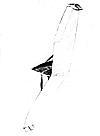Storch IX
Günther Groenhoff died while flying at the Rhön Contest in 1932. This loss of the most skilled test
pilot of tailless and Delta airplanes forced Lippisch to hand over test flying of the rebuilt Delta I and the Delta III to "Bill" Hubert. Hubert also experienced a crash, but survived.
Hubert's crash had come when he had tried to take off without the motor cowling, which adversely affected the directional stability. It was decreed that rear-engine airplanes were dangerous, and all subsequent flights must have the engine mounted in the front with proper cowling.
This led Lippisch to conclude that what was needed was a tailless trainer aircraft to familiarize pilots with their flight characteristics before development of swept-back and Delta aircraft could continue.
So the Storch IX was designed as a trainer. It was a high-wing design with an open cockpit and a hanging control stick.
Another version, featuring a closed cockpit, was built in Darmstadt-Griesheim and was tested by Wiegmeyer. Both planes showed good flight characteristics.
The Storch IXb was a motorized version which featured the wing of the Storch IX, and a 30 hp Bristol-Cherub which had previously used in the Delta I. The Storch IXb was built on the Wasserkuppe in 1933 and flown in 1934 by test pilot Wiegmeyer. Various end plates led to the conclusions that end plates with the rudders installed below the wing tips produced the best stability and controllability.






